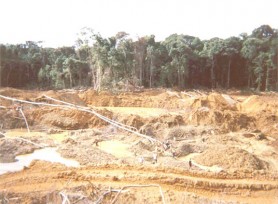-as miners cash in on high prices
Investors in Guyana’s gold industry would do well to take a step back from the prevailing mining frenzy to take a look at informed international assessments of the behaviour of gold prices in the period ahead.

Local miners may have made a killing from the doubling of gold prices, from US$550.00 an ounce early in 2006 to the current price of more than US$1,200.00 an ounce, but a recent assessment of prices by the Economist Intelligence Unit (EIU) suggests that predicting prices in the period ahead can be tricky business.
Not that the predictions for the immediate term prospects for gold prices spell doom and gloom. According to the EIU, the World Gold Council is predicting that global demand will remain robust during 2010 “as a result of accelerating demand from India and China as well as increasing global investment demand driven by continuing uncertainty over public debt and the stuttering (global) economic recovery.” Edward George, a senior economist at the EIU, adds that even if gold prices fall by 20% “we do not believe the price can fall below US$800/troy oz. for long, as over half of current gold mining operations are only profitable at a price of at least $US1,000/troy oz. If the price falls below this level they will simply stop producing, reducing supply and ultimately driving prices up again.”

According to the EIU report, however, equally expert sources in the international gold industry are exercising more than a hint of caution about future gold prices. The report says that Phillip Gibb, manager of the 600 million pound Jupiter Absolute Return Fund, recently sold out his position in gold. The online trading news service Daily FX says that the current rally in gold could be unsustainable, with the bubble set to burst at the first sign of weakness. The EIU Report quotes Daily FX currency strategist IIlya Spivak as saying that “real gold demand looks decidedly lackluster, with use of the metal for the manufacture of jewelry as well as for industrial and dental purposes clearly tracking lower.”
Here in Guyana, a world away from the global trading centres where prices are determined, the focus of investors is on what is—and what has been over the past five years is a steady rise in prices. Last year, increases in price provided a sufficiently strong incentive to push gold production above 300,000 ounces and the resulting returns, even for small scale miners, have spurred a renewed ‘gold rush’ this year. Recently, Executive Secretary of the Guyana Gold and Diamond Miners Association (GGDMA) Edward Shields told Stabroek Business that the potential profitability of investment in the gold industry had caught the attention of some prominent urban businesses, which, having traditionally stayed out of the gold business, are now showing an interest in mining claims.
So intense has the gold fever become that industry watchers are confidently predicting that gold yield for this year could exceed 400,000 ounces, an amount that will exceed last year’s production by almost 100,000 ounces. However, as the EIU report points out, the price of gold “depends solely on demand and supply” and that if large institutional investors pull out “retail investors who bought at the top of the market will be the ones to suffer.”
Though gold analysts warn of the possible risk of a decline in gold prices, none appear ready to predict that the demand for gold will subside in the short term. Amplify Trading, a US trading house points to the likely increasing demand for gold as a “safe haven asset” arising out of the likelihood that some nations may not be able to sustain debt repayments in the event of another global economic downturn. “Also, some countries, such as the UK, may be faced with an inflation problem as well as growth concerns, further increasing the inflation-proof investment of gold,” Amplify Trading says.
If the vagaries of international gold prices pose no bother to local gold miners at this time, efforts to make the proverbial hay while the price remains high could be stymied by emerging differences between the mining sector and the Government of Guyana as the latter moves to implement new mining regulations designed to protect its US$250m five-year forest protection agreement with Norway. Just last week, a visiting Norwegian consulting team was told by the GGDMA that that the new regulations could threaten the livelihoods of the estimated 250,000 people which the industry supports.
Here in Guyana, difficult economic circumstances coupled with consumer awareness of the higher prices of gold has created significantly increased demand for short-term access to cash, a circumstance which has led to an increase in the number of pawnbrokers, though many of these reportedly offer meager amounts for gold jewelry. It is, the EIU Report says, the same on the international market where pawnbrokers are reportedly cashing in.

